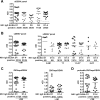Combination of Nonstructural Protein 1-Based Enzyme-Linked Immunosorbent Assays Can Detect and Distinguish Various Dengue Virus and Zika Virus Infections
- PMID: 30429254
- PMCID: PMC6355536
- DOI: 10.1128/JCM.01464-18
Combination of Nonstructural Protein 1-Based Enzyme-Linked Immunosorbent Assays Can Detect and Distinguish Various Dengue Virus and Zika Virus Infections
Abstract
The recent outbreaks of Zika virus (ZIKV) and associated birth defects in regions of dengue virus (DENV) endemicity emphasize the need for sensitive and specific serodiagnostic tests. We reported previously that enzyme-linked immunosorbent assays (ELISAs) based on the nonstructural protein 1 (NS1) of DENV serotype 1 (DENV1) and ZIKV can distinguish primary DENV1, secondary DENV, and ZIKV infections. Whether ELISAs based on NS1 proteins of other DENV serotypes can discriminate various DENV and ZIKV infections remains unknown. We herein developed DENV2, DENV3, and DENV4 NS1 IgG ELISAs to test convalescent- and postconvalescent-phase samples from reverse transcription-PCR-confirmed cases, including 25 primary DENV1, 24 primary DENV2, 10 primary DENV3, 67 secondary DENV, 36 primary West Nile virus, 38 primary ZIKV, and 35 ZIKV with previous DENV infections as well as 55 flavivirus-naive samples. Each ELISA detected primary DENV infection with a sensitivity of 100% for the same serotype and 23.8% to 100% for different serotypes. IgG ELISA using a mixture of DENV1-4 NS1 proteins detected different primary and secondary DENV infections with a sensitivity of 95.6% and specificity of 89.5%. The ZIKV NS1 IgG ELISA detected ZIKV infection with a sensitivity of 100% and specificity of 82.9%. On the basis of the relative optical density ratio, the combination of DENV1-4 and ZIKV NS1 IgG ELISAs distinguished ZIKV with previous DENV and secondary DENV infections with a sensitivity of 91.7% to 94.1% and specificity of 87.0% to 95.0%. These findings have important applications to serodiagnosis, serosurveillance, and monitoring of both DENV and ZIKV infections in regions of endemicity.
Keywords: Zika virus; dengue virus; nonstructural protein 1; serodiagnosis.
Copyright © 2019 American Society for Microbiology.
Figures




Similar articles
-
Distinguishing Secondary Dengue Virus Infection From Zika Virus Infection With Previous Dengue by a Combination of 3 Simple Serological Tests.Clin Infect Dis. 2017 Nov 13;65(11):1829-1836. doi: 10.1093/cid/cix672. Clin Infect Dis. 2017. PMID: 29020159 Free PMC article.
-
A high-throughput and multiplex microsphere immunoassay based on non-structural protein 1 can discriminate three flavivirus infections.PLoS Negl Trop Dis. 2019 Aug 23;13(8):e0007649. doi: 10.1371/journal.pntd.0007649. eCollection 2019 Aug. PLoS Negl Trop Dis. 2019. PMID: 31442225 Free PMC article.
-
Enzyme-linked immunosorbent assays using virus-like particles containing mutations of conserved residues on envelope protein can distinguish three flavivirus infections.Emerg Microbes Infect. 2020 Dec;9(1):1722-1732. doi: 10.1080/22221751.2020.1797540. Emerg Microbes Infect. 2020. PMID: 32684139 Free PMC article.
-
Cross-Reactive T Cell Immunity to Dengue and Zika Viruses: New Insights Into Vaccine Development.Front Immunol. 2019 Jun 11;10:1316. doi: 10.3389/fimmu.2019.01316. eCollection 2019. Front Immunol. 2019. PMID: 31244855 Free PMC article. Review.
-
Modulation of Dengue/Zika Virus Pathogenicity by Antibody-Dependent Enhancement and Strategies to Protect Against Enhancement in Zika Virus Infection.Front Immunol. 2018 Apr 23;9:597. doi: 10.3389/fimmu.2018.00597. eCollection 2018. Front Immunol. 2018. PMID: 29740424 Free PMC article. Review.
Cited by
-
Comparative specificity and sensitivity of NS1-based serological assays for the detection of flavivirus immune response.PLoS Negl Trop Dis. 2020 Jan 29;14(1):e0008039. doi: 10.1371/journal.pntd.0008039. eCollection 2020 Jan. PLoS Negl Trop Dis. 2020. PMID: 31995566 Free PMC article.
-
Identification of prior dengue-naïve Dengvaxia recipients with an increased risk for symptomatic dengue during fever surveillance in the Philippines.Front Immunol. 2023 Jul 24;14:1202055. doi: 10.3389/fimmu.2023.1202055. eCollection 2023. Front Immunol. 2023. PMID: 37554332 Free PMC article.
-
Comparable Accuracies of Nonstructural Protein 1- and Envelope Protein-Based Enzyme-Linked Immunosorbent Assays in Detecting Anti-Dengue Immunoglobulin G Antibodies.Diagnostics (Basel). 2021 Apr 21;11(5):741. doi: 10.3390/diagnostics11050741. Diagnostics (Basel). 2021. PMID: 33919324 Free PMC article.
-
Seroprevalence of Zika Virus in Amphawa District, Thailand, after the 2016 Pandemic.Viruses. 2022 Feb 25;14(3):476. doi: 10.3390/v14030476. Viruses. 2022. PMID: 35336883 Free PMC article.
-
Competitive ELISA for a serologic test to detect dengue serotype-specific anti-NS1 IgGs using high-affinity UB-DNA aptamers.Sci Rep. 2021 Sep 9;11(1):18000. doi: 10.1038/s41598-021-97339-8. Sci Rep. 2021. PMID: 34504185 Free PMC article.
References
-
- Krauer F, Riesen M, Reveiz L, Oladapo OT, Martínez-Vega R, Porgo TV, Haefliger A, Broutet NJ, Low N, WHO Zika Causality Working Group. 2017. Zika virus infection as a cause of congenital brain abnormalities and Guillain-Barré syndrome: systematic review. PLoS Med 14:e1002203. doi:10.1371/journal.pmed.1002203. - DOI - PMC - PubMed
-
- CDC. 2017. Guidance for U.S. laboratories testing for Zika virus infection. CDC, Atlanta, GA. http://www.cdc.gov/zika/laboratories/lab-guidance.html.
Publication types
MeSH terms
Substances
Grants and funding
LinkOut - more resources
Full Text Sources
Medical
Research Materials

